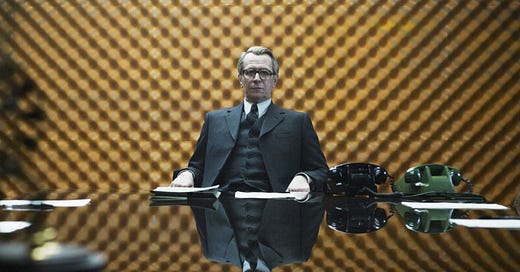More Than Words: Oldman's George Smiley
We are not so very different, you and I. We've both spent our lives looking for the weaknesses in one another.
Playing a new interpretation of a beloved character can be difficult at the best of times, however playing a character made beloved by the late, great Sir Alec Guinness is quite another matter (just ask Ewan McGregor). Guinness first played Smiley in the BBC incarnation of Tinker, Tailor, Soldier, Spy in 1979 and indelibly burnt the character into our psyches forever. Ever since those days, whenever you read or heard the name of George Smiley, the image of a silver-haired Alec Guinness in a bowler hat would inevitably spring into the mind. Even when other highly respected and excellent actors played the part (Denholm Elliot in 1989’sA Murder of Quality), it could never possibly eclipse the harsh spotlight of that performance.
However, Gary Oldman has done just that. Oldman doesn’t play Smiley, Oldman becomes Smiley, he places on the giant glasses and neatly lays beneath the surface of the skin. He wallows in the silences, the strung-out moments of deep contemplation and deliberation, seemingly whispering his way through the film and having others perform his actions while keeping a firm grasp of the strings. In terms of performances, it’s as subtle and un-showy as you could ever imagine. He raises his voice once in the whole film, and it nearly shatters the screen, such is the departure.
For years Oldman had carved a niche out of being a shouty, frantic actor who was essentially a wild man on the screen. Previous performances, such as the hyper-wired Norman Stansfield in Leon were stand out because of the hurricane like nature of his performances, but in recent years Oldman has retreated and transformed into a more introverted and contemplative actor. Smiley is the perfect part for him and he does so much more with a look or a movement than anyone else in the film does with words.
While the other interpretation of Tinker, Tailor has the leg room and time to stretch out the plot and the various complicated machinations, the film instead focusses on the small stuff, particularly on the way George moves, how he thinks, his morning swim to gather his thoughts and oil the cogs and how everything plays out before his tortoise-like eyes. While ostensibly it is a film about a mole hunt, it is actually all about how George, the old vintage car long covered over and abandoned in a garage, is called into service once again to save the day. How his old school methods, while out of sync with the new Circus, are exactly what sails the ship out of troubled waters and restores normality.
This Smiley barely speaks for majority of the film, it is only once things fall into place in George's mind, while watching a train line junction click into place, that George begins to externalise his thoughts with others. Up until that point he is a man of gestures, murmurs and nods. That is until he has a few drinks and bears all to Guillam (Benedict Cumberbatch) regarding his meeting with the elusive Karla. George reveals the mistakes that he made during that meeting that have haunted his career. Being tired and unprepared and giving Karla far too much information about himself, which eventually lead to the bottom falling out of his world. The only time George seems human is when the subject of Anne is raised. He drops his sword, retreats into his shell, loses his calm and changes the subject where possible. This is the weakness that Karla exposes and what costs George his place in the Circus.
There is a wonderful scene that perfectly illustrates Oldman’s Smiley, a bee flies into a car and while everyone else in the car is wafting their hands fruitlessly at it, George takes his time, opens the window and waits for it to leave. A wonderful character study, intending to show us that George uses his mind and reflects on the best solution, rather than needlessly waving his arms at problems.
Oldman's Smiley does so much more with less and for my money, is the best interpretation of the role.




